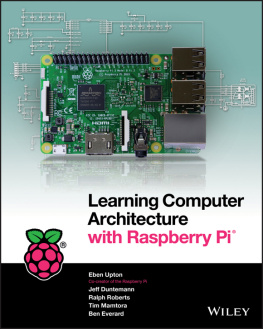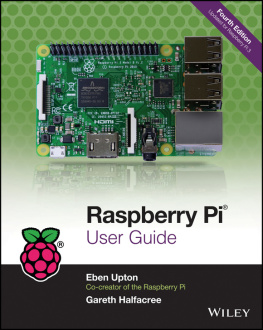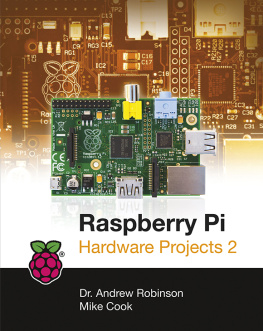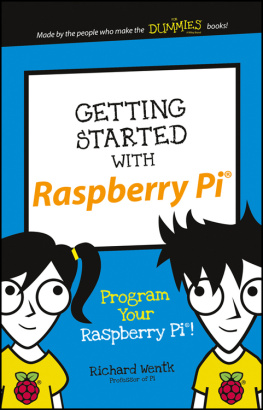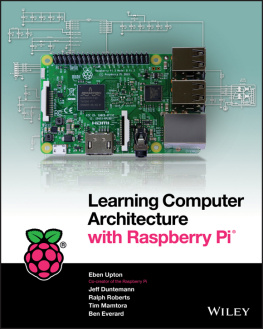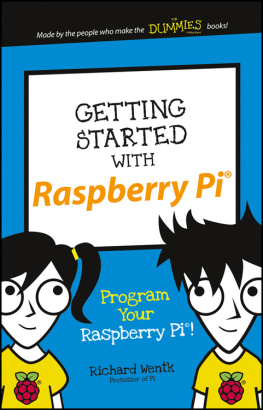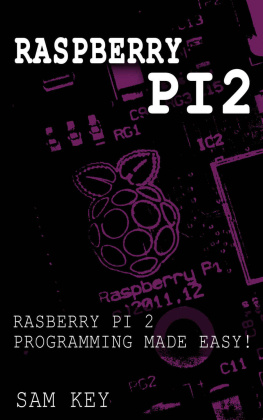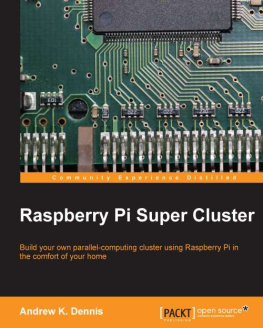

Learning Computer Architecture with Raspberry Pi
Published by
John Wiley & Sons, Inc.
10475 Crosspoint Boulevard
Indianapolis, IN 46256
www.wiley.com
Copyright 2016 by John Wiley & Sons, Inc., Indianapolis, Indiana
Published simultaneously in Canada
ISBN: 978-1-119-18393-8
ISBN: 978-1-119-18394-5 (ebk)
ISBN: 978-1-119-18392-1 (ebk)
No part of this publication may be reproduced, stored in a retrieval system or transmitted in any form or by any means, electronic, mechanical, photocopying, recording, scanning or otherwise, except as permitted under Sections 107 or 108 of the 1976 United States Copyright Act, without either the prior written permission of the Publisher, or authorization through payment of the appropriate per-copy fee to the Copyright Clearance Center, 222 Rosewood Drive, Danvers, MA 01923, (978) 750-8400, fax (978) 646-8600. Requests to the Publisher for permission should be addressed to the Permissions Department, John Wiley & Sons, Inc., 111 River Street, Hoboken, NJ 07030, (201) 748-6011, fax (201) 748-6008, or online at http://www.wiley.com/go/permissions .
LIMIT OF LIABILITY/DISCLAIMER OF WARRANTY: THE PUBLISHER AND THE AUTHOR MAKE NO REPRESENTATIONS OR WARRANTIES WITH RESPECT TO THE ACCURACY OR COMPLETENESS OF THE CONTENTS OF THIS WORK AND SPECIFICALLY DISCLAIM ALL WARRANTIES, INCLUDING WITHOUT LIMITATION WARRANTIES OF FITNESS FOR A PARTICULAR PURPOSE. NO WARRANTY MAY BE CREATED OR EXTENDED BY SALES OR PROMOTIONAL MATERIALS. THE ADVICE AND STRATEGIES CONTAINED HEREIN MAY NOT BE SUITABLE FOR EVERY SITUATION. THIS WORK IS SOLD WITH THE UNDERSTANDING THAT THE PUBLISHER IS NOT ENGAGED IN RENDERING LEGAL, ACCOUNTING, OR OTHER PROFESSIONAL SERVICES. IF PROFESSIONAL ASSISTANCE IS REQUIRED, THE SERVICES OF A COMPETENT PROFESSIONAL PERSON SHOULD BE SOUGHT. NEITHER THE PUBLISHER NOR THE AUTHOR SHALL BE LIABLE FOR DAMAGES ARISING HEREFROM. THE FACT THAT AN ORGANIZATION OR WEBSITE IS REFERRED TO IN THIS WORK AS A CITATION AND/OR A POTENTIAL SOURCE OF FURTHER INFORMATION DOES NOT MEAN THAT THE AUTHOR OR THE PUBLISHER ENDORSES THE INFORMATION THE ORGANIZATION OR WEBSITE MAY PROVIDE OR RECOMMENDATIONS IT MAY MAKE. FURTHER, READERS SHOULD BE AWARE THAT INTERNET WEBSITES LISTED IN THIS WORK MAY HAVE CHANGED OR DISAPPEARED BETWEEN WHEN THIS WORK WAS WRITTEN AND WHEN IT IS READ.
For general information on our other products and services please contact our Customer Care Department within the United States at (877) 762-2974, outside the United States at (317) 572-3993 or fax (317) 572-4002.
Library of Congress Control Number: 2016945538
Trademarks: Wiley and the Wiley logo are trademarks or registered trademarks of John Wiley & Sons, Inc. and/or its affiliates, in the United States and other countries, and may not be used without written permission. All other trademarks are the property of their respective owners. John Wiley & Sons, Inc. is not associated with any product or vendor mentioned in this book.
Publishers Acknowledgements
VP Consumer and Technology Publishing Director:
Michelle Leet
Professional Technology & Strategy Director:
Barry Pruett
Marketing Manager:
Lorna Mein
Acquisitions Editor:
Jody Lefevere
Project Editor:
Charlotte Kughen
Copy Editor:
Grace Fairley
Technical Editor:
Omer Kilic
Editorial Manager:
Mary Beth Wakefield
Editorial Assistant:
Matthew Lowe
About the Authors
EBEN UPTON is a founder of the Raspberry Pi Foundation, serves as the CEO of Raspberry Pi (Trading) Ltd, its trading arm, and is the co-author, with Gareth Halfacree, of the Raspberry Pi User Guide. In an earlier life, Eben founded two successful mobile games and middleware companies (Ideaworks 3d and Podfun), held the post of Director of Studies for Computer Science at St Johns College, Cambridge and wrote the Oxford Rhyming Dictionary with his father, Professor Clive Upton. He holds a BA in Physics and Engineering, a PhD in Computer Science, and an Executive MBA, from the University of Cambridge.
JEFF DUNTEMANN has been professionally published in both technical nonfiction and science fiction since 1974. He worked as a programmer for Xerox Corporation and as a technical editor for Ziff-Davis Publishing and Borland International. He launched and edited two print magazines for programmers and has 20 technical books to his credit, including the best-selling Assembly Language Step By Step. He wrote the Structured Programming column in Dr. Dobbs Journal for four years and has published dozens of technical articles in many magazines. With fellow writer Keith Weiskamp, Jeff launched The Coriolis Group in 1989, which went on to become Arizonas largest book publisher by 1998. He has a longstanding interest in strong artificial intelligence, and most of his fiction (including his two novels, The Cunning Blood and Ten Gentle Opportunities) explore the consequences of strong AI. His other interests include electronics and amateur radio (callsign K7JPD), telescopes and kites. Jeff lives in Phoenix, Arizona with Carol, his wife of 40 years, and four bichon frise dogs.
RALPH ROBERTS is a decorated Vietnam Veteran who worked with NASA during the Apollo moon-landing program and has been writing about computers and software continuously since his first sale to Creative Computing magazine in 1979. Roberts has written more than 100 books for national publishers and thousands of articles and short stories. In all, hes sold more than 20 million words professionally. His best sellers include the first U.S. book on computer viruses (which resulted in several appearances on national TV) and Classic Cooking with Coca-Cola, a cookbook that has been in print for the past 21 years and has sold 500,000 copies.
TIM MAMTORA works as a master engineer in IC Design for Broadcom Limited and is currently the technical lead for the internal GPU hardware team. He has worked in mobile computer graphics for nearly seven years and previously held roles developing internal IP for analog TV and custom DSP hardware. Tim holds a Masters in Engineering from the University of Cambridge, and he spent his third year at the Massachusetts Institute of Technology, which sparked his interest in digital hardware design. He is passionate about promoting engineering and has dedicated time to supervising undergraduates at the University of Cambridge and giving talks about opportunities in engineering to his old school. Outside of work he enjoys a variety of sports, photography and seeing the world.
BEN EVERARD is a writer and podcaster who spends his days tinkering with Linux and playing with robots. This is his second book; he also wrote Learning Python with Raspberry Pi (Wiley, 2014). You can find him on Twitter at @ben_everard .
About the Technical Editor
OMER KILIC is an embedded systems engineer who enjoys working with small connected computers of all shapes and sizes. He works at the various intersections of hardware and software engineering practices, product development and manufacturing.
In memory of Alan Drew, without whom I would have stopped before I got started.
Eben Upton
To the eternal memory of Steve Ostruszka 1917-1990, who gave me his daughters hand and honored me with his friendship.
Next page
